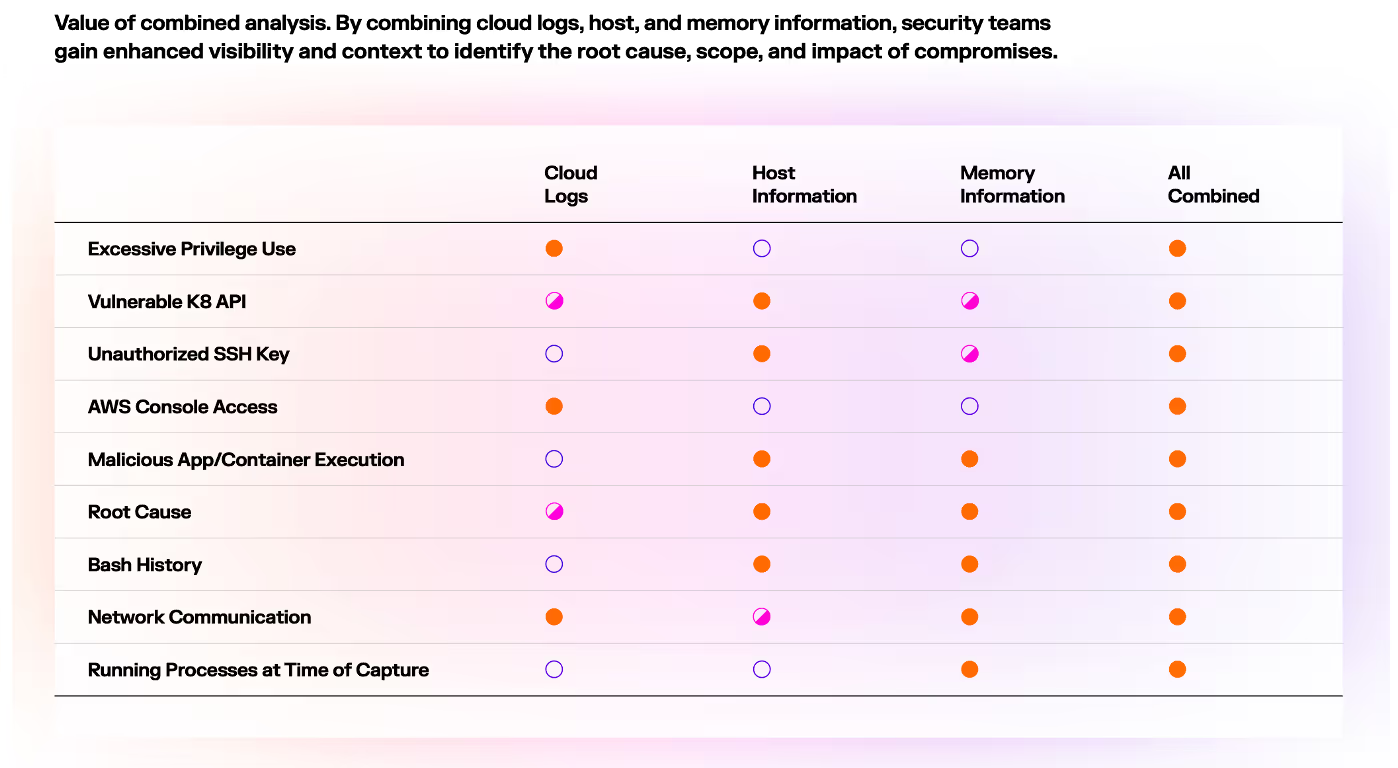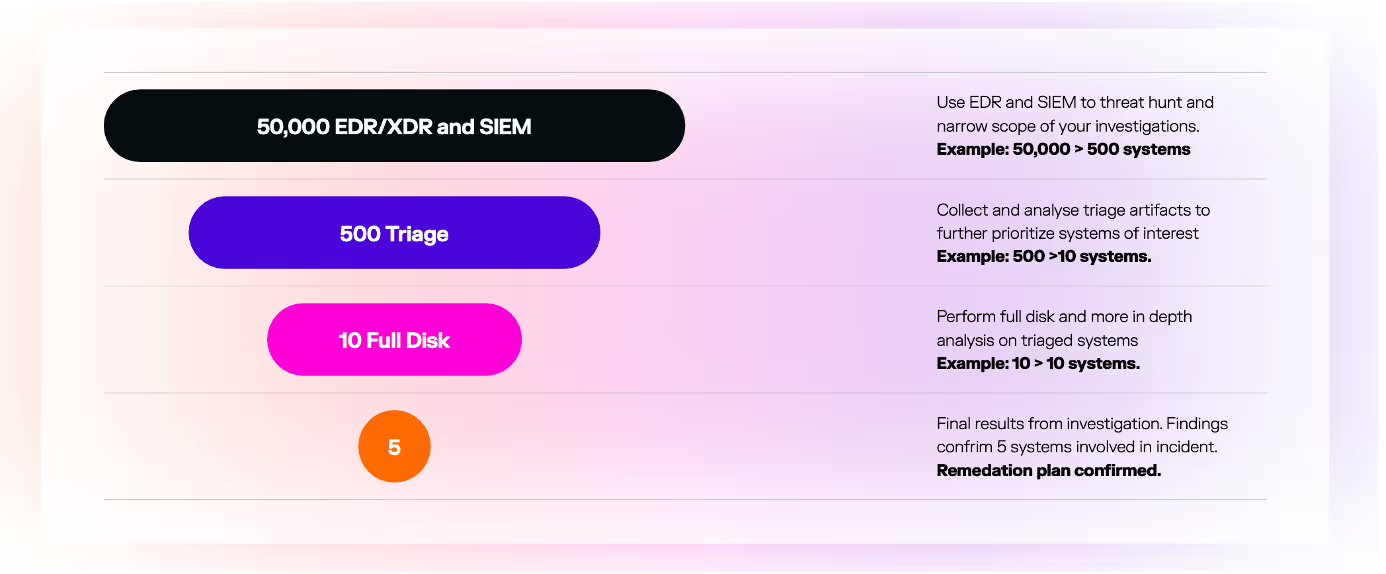The speed and scale at which new cloud resources can be spun up has resulted in uncontrolled deployments, misconfigurations, and security risks. It has had security teams racing to secure their business’ rapid migration from traditional on-premises environments to the cloud.
While many organizations have successfully extended their prevention and detection capabilities to the cloud, they are now experiencing another major gap: forensics and incident response.
Once something bad has been identified, understanding its true scope and impact is nearly impossible at times. The proliferation of cloud resources across a multitude of cloud providers, and the addition of container and serverless capabilities all add to the complexities. It’s clear that organizations need a better way to manage cloud incident response.
Security teams are looking to move past their homegrown solutions and open-source tools to incorporate real cloud forensics capabilities. However, with the increased buzz around cloud forensics, it can be challenging to decipher what is real cloud forensics, and what is “fauxrensics.”
This blog covers the five core capabilities that security teams should consider when evaluating a cloud forensics and incident response solution.
[related-resource]
1. Depth of data
There have been many conversations among the security community about whether cloud forensics is just log analysis. The reality, however, is that cloud forensics necessitates access to a robust dataset that extends far beyond traditional log data sources.
While logs provide valuable insights, a forensics investigation demands a deeper understanding derived from multiple data sources, including disk, network, and memory, within the cloud infrastructure. Full disk analysis complements log analysis, offering crucial context for identifying the root cause and scope of an incident.
For instance, when investigating an incident involving a Kubernetes cluster running on an EC2 instance, access to bash history can provide insights into the commands executed by attackers on the affected instance, which would not be available through cloud logs alone.
Having all of the evidence in one place is also a capability that can significantly streamline investigations, unifying your evidence be it disk images, memory captures or cloud logs, into a single timeline allowing security teams to reconstruct an attacks origin, path and impact far more easily. Multi–cloud environments also require platforms that can support aggregating data from many providers and services into one place. Doing this enables more holistic investigations and reduces security blind spots.
There is also the importance of collecting data from ephemeral resources in modern cloud and containerized environments. Critical evidence can be lost in seconds as resources are constantly spinning up and down, so having the ability to capture this data before its gone can be a huge advantage to security teams, rather than having to figure out what happened after the affected service is long gone.

2. Chain of custody
Chain of custody is extremely critical in the context of legal proceedings and is an essential component of forensics and incident response. However, chain of custody in the cloud can be extremely complex with the number of people who have access and the rise of multi-cloud environments.
In the cloud, maintaining a reliable chain of custody becomes even more complex than it already is, due to having to account for multiple access points, service providers and third parties. Having automated evidence tracking is a must. It means that all actions are logged, from collection to storage to access. Automation also minimizes the chance of human error, reducing the risk of mistakes or gaps in evidence handling, especially in high pressure fast moving investigations.
The ability to preserve unaltered copies of forensic evidence in a secure manner is required to ensure integrity throughout an investigation. It is not just a technical concern, its a legal one, ensuring that your evidence handling is documented and time stamped allows it to stand up to court or regulatory review.
Real cloud forensics platforms should autonomously handle chain of custody in the background, recording and safeguarding evidence without human intervention.
3. Automated collection and isolation
When malicious activity is detected, the speed at which security teams can determine root cause and scope is essential to reducing Mean Time to Response (MTTR).
Automated forensic data collection and system isolation ensures that evidence is collected and compromised resources are isolated at the first sign of malicious activity. This can often be before an attacker has had the change to move latterly or cover their tracks. This enables security teams to prevent potential damage and spread while a deeper-dive forensics investigation takes place. This method also ensures critical incident evidence residing in ephemeral environments is preserved in the event it is needed for an investigation. This evidence may only exist for minutes, leaving no time for a human analyst to capture it.
Cloud forensics and incident response platforms should offer the ability to natively integrate with incident detection and alerting systems and/or built-in product automation rules to trigger evidence capture and resource isolation.

4. Ease of use
Security teams shouldn’t require deep cloud or incident response knowledge to perform forensic investigations of cloud resources. They already have enough on their plates.
While traditional forensics tools and approaches have made investigation and response extremely tedious and complex, modern forensics platforms prioritize usability at their core, and leverage automation to drastically simplify the end-to-end incident response process, even when an incident spans multiple Cloud Service Providers (CSPs).
Useability is a core requirement for any modern forensics platform. Security teams should not need to have indepth knowledge of every system and resource in a given estate. Workflows, automation and guidance should make it possible for an analyst to investigate whatever resource they need to.
Unifying the workflow across multiple clouds can also save security teams a huge amount of time and resources. Investigations can often span multiple CSP’s. A good security platform should provide a single place to search, correlate and analyze evidence across all environments.
Offering features such as cross cloud support, data enrichment, a single timeline view, saved search, and faceted search can help advanced analysts achieve greater efficiency, and novice analysts are able to participate in more complex investigations.
5. Incident preparedness
Incident response shouldn't just be reactive. Modern security teams need to regularly test their ability to acquire new evidence, triage assets and respond to threats across both new and existing resources, ensuring readiness even in the rapidly changing environments of the cloud. Having the ability to continuously assess your incident response and forensics workflows enables you to rapidly improve your processes and identify and mitigate any gaps identified that could prevent the organization from being able to effectively respond to potential threats.
Real forensics platforms deliver features that enable security teams to prepare extensively and understand their shortcomings before they are in the heat of an incident. For example, cloud forensics platforms can provide the ability to:
- Run readiness checks and see readiness trends over time
- Identify and mitigate issues that could prevent rapid investigation and response
- Ensure the correct logging, management agents, and other cloud-native tools are appropriately configured and operational
- Ensure that data gathered during an investigation can be decrypted
- Verify that permissions are aligned with best practices and are capable of supporting incident response efforts
Cloud forensics with Darktrace
Darktrace delivers a proactive approach to cyber resilience in a single cybersecurity platform, including cloud coverage. Darktrace / CLOUD is a real time Cloud Detection and Response (CDR) solution built with advanced AI to make cloud security accessible to all security teams and SOCs. By using multiple machine learning techniques, Darktrace brings unprecedented visibility, threat detection, investigation, and incident response to hybrid and multi-cloud environments.
Darktrace’s cloud offerings have been bolstered with the acquisition of Cado Security Ltd., which enables security teams to gain immediate access to forensic-level data in multi-cloud, container, serverless, SaaS, and on-premises environments.
[related-resource]
Need help evaluating cloud security solutions?
Discover five essential capabilities for effective cloud forensics and incident response and how AI-based security solutions can make a difference.
.avif)
















.jpg)
